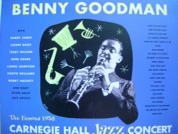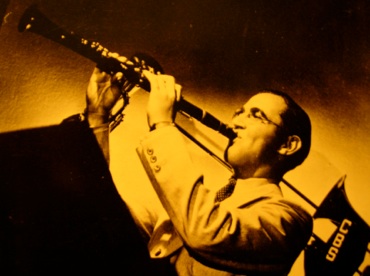topic bg/38
the controversy surrounding
benny goodman’s famous
1938 carnegie hall concert

topic bg/38
the controversy surrounding
benny goodman’s famous
1938 carnegie hall concert

Benny Goodman’s 1938 Carnegie Hall Concert was a milestone in music history. The concert was recorded, and twelve years later was released on Columbia Records. These records sold in the millions, and paved the way for two new genres of jazz records (and two new sources of income for the major record labels as a supplement to new studio recordings) the concert recording, and (with regards to swing music) the recorded radio broadcasts of the 1930s and ‘40s. After the BG Carnegie ’38 album took off, the major labels began to comb the archives ---the output of Benny Goodman records of this variety alone would easily bend the sturdiest of record shelves.
When CDs were introduced in the ’80’s, Columbia Records would soon provide, yet again, a digital version of the famous Goodman concert. (The LP version, by the way, never went out of print during the LP era.) Then, in 1999 Columbia made it’s definitive version of the Goodman Carnegie Hall Concert. This two-CD set claimed to have the best sound quality ever, and was unedited, that is, given the luxury of space that two CDs would provide, Columbia would include everything that had been preserved.
In the spring of 2000, a traditional jazz monthly magazine, The Mississippi Rag, published a review of the new Columbia release. It was written by Joe Klee, a traditional jazz stalwart and frequent contributer to the magazine. Though not an avid letter writer, nor one to relish in the debunking of myths, I had some serious reservations about the claims by Columbia Records, highly touted in their promotional materials for the release, that this CD set sounded better than anything before. The letter I wrote, that The Mississippi Rag published in August 2000, is reprinted here. It gives some additional background and, I hope, explains my “theories” on the matter.
Letter to THE MISSISSIPPI RAG
August, 2000 issue
“THEY LEFT OUT THE WHISTLE!”
By Eric Bogart
Joe Klee’s adroit review of Columbia’s re-issue of Benny Goodman’s 1938 Carnegie Hall Concert offers a very brief inventory of the prior incarnations of the concert on LP and CD. There’s probably much to tell about the history of the various issues (45rpm, EPs, foreign releases, commemorations, etc.) of this concert on vinyl alone.
Because of the impact that this recording has had on me as a high school senior in the early 1970s (I think I played the double LP set every night for six months!), I’ve made it a point to seek out every version that I could get my hands on, including what I believe is the very first release.
Though most fans of a certain age would would be most familiar with the Columbia box set with Goodman photographed before a colorful abstract painting, the original set was a dowel-hinged box (the art work is reproduced on the new Columbia CD reissue) with two Blue labeled LPs. The various numbers, letters and symbols etched into the vinyl on these records is best left to a separate investigation. Suffice to say that THE “first release” is different from all the rest that would follow. When compared visually to the other pressings, this edition has a wider spacing between the cuts. And this is not true of the almost identical green labeled sets, also packaged in the dowel-hinged box, which must have been released around then.
Over the years, I’ve taken great pleasure performing “A-B Tests” for musicians, record collectors and BG fans, between the blue label “first release” and any other versions, especially the original Columbia CD release which Klee mentions, and watching their jaws drop, so to speak. New York DJ, Rich Conaty, gave considerable air time to this subject, after a visit to my home in Miami.
The difference in sonic quality, “the clarity of tone, the definition of instruments...the audible presence of the drummer’s cymbals...” as my old friend Phil Schaap, relates in his notes (as producer of the set), holds true for my blue label “first release” in comparison to all others I own. In short, astounding!
Skeptics might believe that my blue labeled set might just be unusually clean, or mastered louder than later issues, but, there is one crucial difference! A whistle! Just before the opening note by the Goodman band is sounded on the concert’s first song, “Don’t Be That Way,” there is a whistle discernible from somewhere in the audience. This whistle has been deleted from all subsequent versions.
This might seem a silly point (and my apologies to Turk Van Lake, who in his notes to the new CD release, claims that there was “no whistling” from the well behaved audience in attendance. But in all seriousness, this whistle serves as a “marker” which indicates that a new or separate tape master was probably made within a short span of time back in 1950. Why?
There may be nothing unusual here. I’m not well enough aware of the procedures at Columbia Records at that time (or any time) to say that this might be something out of the ordinary. But there IS quite a lot of 78rpm type surface noise on th “blue label” edition throughout the album, and a lot less of it from the “whistle-less” green label version, from a similar vintage.
My take on all of this is that it seems likely that some Columbia execs, or others involved, thought that the album, as it first appeared, was just full of too many pops and scratches and decided then-and-there to EQ the highs, and thus began a process that over the years would make for a very muffled version of what happened in Carnegie Hall in 1938.
So, where does this leave the new Columbia CD release in a “A-B Test”? With all due respect to Columbia, and to Mr. Schaap, the “blue label” set wins out, once again, whistle and all.
P.S. Hey, Turk! About that whistle --- was it you?
This letter, in itself, may have caused no particular stir whatsoever when it was published in the summer of ‘00. But a couple of years down the road my dear friend Lloyd Rauch passed along some print-outs from another dear friend, Dave Weiner, who was monitoring back-and-forth discussions on the internet in a record collector’s “chat room.” It was obvious that battle lines were being drawn in a argument by “interested parties” questioning the quality of the production of this “definitive” CD set release by Columbia.
The real whopper in all this was that one of the “interested parties”, was none-other-than George Avakian, the ORIGINAL producer of the Carnegie Hall album back in 1950. (At this writing, he’s still going strong, and as was mentioned in the N.Y. Times recently, has just received a National Endowment For The Arts Award.) Inevitably my name did come up in these e-mail exchanges, and it was great fun to read some of the “expert” analysis of “The Whistle Theory” and other such matters.
And that’s not all! The record collectors “in the know” started passing around their own “remastered versions of the BG concert, and now there are some “bootleg” imports available claiming improved sound quality over Columbia’s own CD set!
Well, would I ever have imagined back in my high school days, enraptured by that glorious music recorded back in January 1938, that what was a curiosity to me and a source of entertainment to those with whom I shared my discoveries, would become so serious a matter? And it is certainly heartening to know that some people still care enough about the integrity of what I believe is a musical treasure, to go to bat for it and insist on only the highest of high standards.
Like I say, I don’t claim to have gotten the ball rolling on this public discussion regarding Benny Goodman’s 1938 Carnegie Hall Concert, but I can at least take credit for having fired the opening salvo in what would ultimately boil over to become quite a controversy, indeed!
EB
P.S. I HAVE INCLUDED AN “A-B TEST” FROM THE SONG “DIZZY SPELLS” BY THE BENNY GOODMAN QUARTET. UNLESS YOUR COMPUTER IS HOOKED UP TO A GOOD SOUND SYSTEM, I SUGGEST THAT YOU LISTEN TO THIS SOUND SAMPLE WITH HEADPHONES, OTHERWISE (ESPECIALLY ON TYPICAL LAPTOP SPEAKERS) YOU MAY MISS THE WHOLE EFFECT.

This “A/B Test” compares the recent Columbia Records
CD release with the 1950 “Blue Label” original Columbia LP, and they will be heard in that order.
The beginning of the song’s bridge is where it switches to the 1950 LP, then back again ---- from this point on the switches back and forth are obvious, because the music skips each time.
EB
Click here
to continue